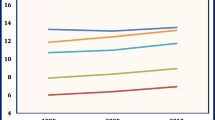Abstract
Many developing countries have introduced social health insurance programs to help address two of the United Nations’ millennium development goals—reducing infant mortality and improving maternal health outcomes. By making modern health care more accessible and affordable, policymakers hope that more women will seek prenatal care and thereby improve health outcomes. This paper studies how Ghana’s social health insurance program affects prenatal care use and out-of-pocket expenditures, using the two-part model to model prenatal care expenditures. We test whether Ghana’s social health insurance improved prenatal care use, reduced out-of-pocket expenditures, and increased the number of prenatal care visits. District-level differences in the timing of implementation provide exogenous variation in access to health insurance, and therefore strong identification. Those with access to social health insurance have a higher probability of receiving care, a higher number of prenatal care visits, and lower out-of-pocket expenditures conditional on spending on care.




Similar content being viewed by others
Notes
Cash and carry is a sales policy or a method of purchase in which the customer must remit payment at the point of service and must take the item with you. In the context of this paper, it can be seen as paying for health care before you receive the necessary treatment.
I used the average Ghana cedi to USD rate within the survey period at a rate of ₵ 9,500 \(=\) $1, which is valued in the old Ghana cedi. Ghana’s cedi currency was redenominated in July 2007 at a rate of ₵ 10,000 \(=\) GH₵ 1.
This number is currently 145 as of May 2014.
A household, according to the definition of GSS, consists of a person or group of related or unrelated persons, who live together in the same housing unit, who acknowledge one adult male or female as the head of the household, who share the same housekeeping and cooking arrangements.
References
Asenso-Boadi, F. (2009). Ghana’s National Health Insurance System: Design, implementation perspectives. Presentation on behalf the CEO of NHIA, at the African Health Economics and Policy Association Conference, 10th March, Accra.
Belotti, F., Deb, P., Manning, W. G., & Norton, E. C. (2014). Tpm: Estimating two-part models. Stata Journal (forthcoming).
Boehmer, U., & Williamson, J. (1996). The impact of women’s status on infant mortality rate: A cross-national analysis. Social Indicators Research, 37(3), 333–360.
Chen, C., & Liu, T. (2004). The role of Taiwan’s national health insurance program in influencing adequate prenatal care. International Journal of Health Planning and Management, 19, 113–130.
Chen, L., Chen, C., & Yang, W. (2008). The influences of Taiwan’s National Health Insurance on women’s choice of prenatal care facility: Investigation of differences between rural and non-rural areas. BMC Health Services Research, 8, 67.
Cokkinides, V. (2001). Health Insurance coverage—Enrollment and adequacy of prenatal care utilisation. Journal of Health Care for the Poor and Undeserved, 12, 4.
Corman, H., & Grossman, M. (1985). Determinants of neonatal mortality rates in the U.S. Journal of Health Economics, 4, 213–236.
Dow, W. H., & Norton, E. C. (2003). Choosing between and interpreting the Heckit and two-part models for corner solutions. Health Services and Outcomes Research Methodology, 4(1), 5–18.
Duan, N., Manning, W., Morris, N., & Newhouse, P. (1982). A comparison of alternative models for the demand for medical care. Journal of Business & Economic Statistics, 1(2), 115–126.
Duan, N. (1983). Smearing estimate: A nonparametric retransformation method. Journal of the American Statistical Association, 78, 605–610.
Ghana Health Service. (2009a). Evaluation of the Ghana National Health Insurance Scheme. Bethesda, MD: Health Systems 20/20 Project and Abt Associates Inc.
Ghana Health Service. (2009b). Annual report 2009. Accra: Ghana Health Service.
Republic of Ghana. (2004). National Health Insurance Regulations, 2004 (L.I.1809). Accra.
Ghana Statistical Service. (2008). Ghana Living Standards Survey V Report.
Grossman, M., & Jacobowitz, S. (1981). Variations in infant mortality rates among counties of the United States: The role of public policies and programs. Demography, 18, 695–713.
Hay, W., & Olsen, J. (1984). Let them eat cake: A note comparing alternative models of the demand for medical care. Journal of Business & Economic Statistics, 2(3), 279–282.
Kaestner, R. (1999). Health insurance, the quantity and quality of prenatal care, and infant health. Inquiry, 36, 2.
Long, Q., Zhang, T., Hemminki, I., Tang, X., Huang, K., & Tolhurst, R. (2010). Utilisation, contents and costs of prenatal care under a rural health insurance (New Co-operative Medical System) in rural China: Lessons from implementation. BMC Health Services Research, 2010(10), 301.
Osborne, J. (2010). Improving your data transformations: Applying the Box–Cox transformations. Practical Assessment, Research & Evaluation, 15(12), 1–9.
Powell-Jackson, T., Hanson, K., Whitty, C. J., & Ansah, E. K. (2013). Who benefits from free healthcare? Evidence from a randomized experiment in Ghana. Journal of Development Economics, 107, 305–319.
Simkhada, B., Teijlingen, R., Porter, M., & Simkhada, P. (2008). Factors affecting the utilisation of antenatal care in developing countries: Systematic review of the literature. Journal of Advanced Nursing, 61(3), 244–260.
Smith, V., & Sulzbach, S. (2006). Community-based health insurance and access to maternal health services: Evidence from three West African countries. Social Science and Medicine Journal, 66, 2460–2473.
World Bank. (2007). Project appraisal document on a proposed credit to the Republic of Ghana for a Health Insurance project. Washington, DC: World Bank.
World Health Organization. (2001). WHO antenatal care randomized trial—Manual for the implementation of the new model. Geneva: WHO.
World Health Organization. (2007). Maternal mortality in 2005—Estimates developed by WHO, UNICEF, UNFPA, and the World Bank. Geneva: WHO.
World Health Organization. (2010). Country cooperation strategy: At a glance. Geneva: WHO.
Zanconato, G., Msolomba, R., Guarenti, L., & Franchi, M. (2006). Antenatal care in developing countries: The need for a tailored model. Seminars in Fetal Neonatal Medicine, 11(1), 15–20.
Author information
Authors and Affiliations
Corresponding author
Appendix
Appendix
Rights and permissions
About this article
Cite this article
Abrokwah, S.O., Moser, C.M. & Norton, E.C. The effect of social health insurance on prenatal care: the case of Ghana. Int J Health Care Finance Econ 14, 385–406 (2014). https://doi.org/10.1007/s10754-014-9155-8
Received:
Accepted:
Published:
Issue Date:
DOI: https://doi.org/10.1007/s10754-014-9155-8



